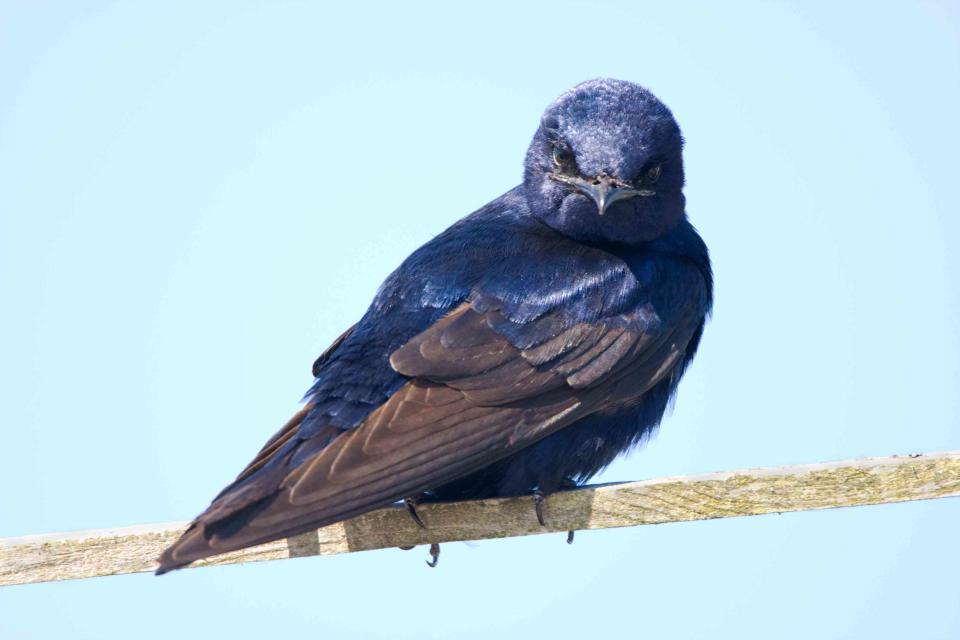How To Attract Purple Martins To Your Yard, According To An Expert
A proper house will bring all these songbirds to the yard.

Getty Images
Nothing is more beautiful to the eyes or ears than Purple Martins, especially if they’ve decided to take up residence in your yard or garden. The good news is that east of the Rocky Mountains, these beautiful songbirds nest almost exclusively in housing that humans create.
"They are dependent on us for their survival," the Purple Martin Conservation Association states on their website. "They are one of America’s most well-loved songbirds for many reasons; their chattering song, aerial acrobatics, insect-eating habits, and their tolerance of humans."
But what is the best way to attract Purple Martins to your yard? It starts with proper housing.
"Install a Purple Martin house," Audubon Florida’s communications director Erika Zambello tells Southern Living. "They come in a variety of shapes and sizes, from miniature houses to gourd-shapes mounted on poles."
Meet Our Expert
Erika Zambello is the communications director for Audubon Florida.
When Do Purple Martins Migrate?
Purple Martins spend the winter months in South America before migrating to portions of Mexico, the United States, and Canada to breed during the summer.
"They return to Florida in January and can be seen all the way up in New England by mid-April, making them one of the earliest songbirds to arrive for the breeding season," Zambello says.
What Do Purple Martins Look Like?
Purple Martins are beautiful, acrobatic songbirds.
"Males are a stunning, deep blue hue, while females and juveniles have white undersides," Zambello says.
The Purple Martin Conservation Association states that although they are distinctive birds, there are several species that are commonly mistaken for Purple Martins, including: Tree Swallows, Barn Swallows, Bank Swallows, European Starlings, and Cliff Swallows.
Related: The Best Birding Supplies and Bird Watching Gear

Getty Images
Best Ways To Attract Purple Martins
Installing a Purple Martin house is the single best way to attract the species to your yard, but house placement is crucial.
"Houses should be placed 30 to 40 feet, at minimum, from trees, houses, or other infrastructure," Zambello says.
Key Elements of Purple Martin House
A proper Purple Martin house is a multi-room home on a pole that includes perch rods, predator guards, and vertical accessibility. According to Purple Martin Conservation Association, those interested in utilizing a Purple Martin house should also consider the following:
The Right Material: Consider aluminum, thick plastic, untreated 3/4” wood, or natural gourds for Purple Martin housing, making sure the exterior color is white. “White reflects heat, keeping housing cooler in hot temperatures,” the website states.
A Suitable Entrance Hole: Make sure the entrance hole for Purple Martins is suitable. "Traditional round entrance holes are generally 2-1/8 inches in diameter, but a range between 1-3/4 inches and 2-1/4 inches is acceptable," the website suggests.
The Proper Weather Protection: Because Purple Martin houses should be placed in an open area, the likelihood of being exposed to wind, rain, and other weather elements is high. The Purple Martin Conservation Association emphasizes the importance of ventilation, drainage, and insulation, especially because newborn nestlings are prone to hypothermia. "Ventilation holes should be drilled at an upward angle or placed under the roof overhang to prevent water from funneling into the compartments. Drain holes in the bottom of each compartment or gourd will allow wet nests to dry more quickly," the website states. "The roof overhang can be extended to help protect compartments from rain, and raised subfloors also offer protection. A layer of insulation in the attic of plastic or metal housing will protect martins during periods of extreme temperatures."
A Clean House: The University of Missouri stresses the importance of checking Purple Martin houses throughout the season for both safety of eggs and cleanliness of the space."Prevent nest boxes from being overtaken by other birds by keeping entrance holes closed until early March," the website states.
Zambello tells Southern Living that putting out crushed eggshells can also bring Purple Martins to your yard. "They use the hard shells in their digestive system as they work to digest their insect diet," she says.
Related: The Best Bird Feeders for Your Backyard
What To Avoid
Zambello emphasizes the importance of protecting Purple Martins and the critical role they play in ecosystems all over the world.
"Purple Martins connect us across neighborhoods, states, countries, and continents,” she says. “We must protect their habitat across their migratory pathway and protect their food source—insects—so they can survive and thrive.”
Reflective Glass: "Purple Martins can hit windows, thinking the reflective glass is an expanse of sky," Zambello explains. "Close the blinds or put up vertical cords, adhesive window clings, or even drawings with oil-based markers to break up the reflection and reduce window strikes for all birds, including Purple Martins."
Chemicals: "Avoid pesticide and insecticide use on your lawns or in your gardens," Zambello says. "Purple Martins need a lot of insects to survive and raise their chicks. The more insects the better."
Related: How To Attract Bluebirds To Your Garden, According To An Expert
For more Southern Living news, make sure to sign up for our newsletter!
Read the original article on Southern Living.

